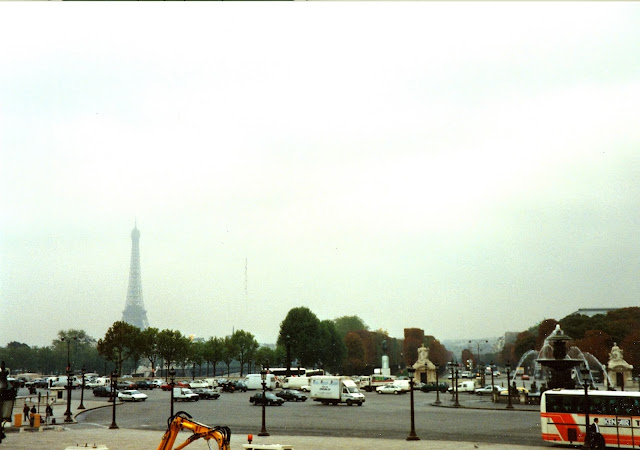1992 - Paris France
These photos are from our first trip to Paris which we combined with a visit to Brussels Belgium and Dublin.
This is way before digital and the internet had not been heard of by us regular folks. These are our scanned photos.
To book our hotel, I HAD to go to the library and get a tour book, I found a hotel under BUDGET, then we HAD to incur a long distance phone charge to book the hotel.
Upon checking in the clerk asked how we had found the hotel, we said tour book, she said, oh we've done some major renovations...
It still exists as a four star property.
Located on rue Git Le Coeur (translates curiously as "there lies the heart") in the Latin Quarter, the Relais Hotel du Vieux Paris is the former Beat Hotel, birthplace of the Beat Generation.
The Relais-Hôtel du Vieux Paris has a history all its own! Built in 1480, it belonged to the Duc de Luynes and the Duc d’O and was once the dwelling place of Pierre Seguier, the true Marquis d’O. In the 1950s and 60s, American poets adopted the site and created the “Beat Generation”. Among them were Burroughs, Kerouac, Ginsberg, Corso.
All the magic is there, right around the corner.The banks of the Seine, the Latin Quarter, its typical cafes and restaurants, the Flower Market, Notre-Dame, the Louvre. All the charm of memories is here, in the hotel which was the starting place for the Beat Generation.
And did we get a surprise when we checked out! Our bill was $1,000 for three nights! Don't forget this was 1992! I can still see us staggering down the street laughing hysterically wondering how we were going to pay our credit card bill!
Anyway, on to the sights. I didn't do a good job labeling photos back then.
The Cat Who Fishes
Notre Dame. Click here for our 2012 city tour that covers many of the sights mentioned.
Pont Alexandre III It connects the Champs-Élysées quarter with those of the Invalides and Eiffel Tower. The bridge is widely regarded as the most ornate, extravagant bridge in the city.
At the centre of the 7th arrondissement on the Left Bank, the grand complex of Hôtel des Invalides is easily recognisable with its magnificent gilded dome. Inside the church lies the tomb of Napoleon Bonaparte.
The obelisk known as the Place de la Concorde was one of a pair given as a gift from Egypt to France the the late 1820’s. This single piece of red granite some 75 feet tall, and weighing 280 tons, was erected in Paris in 1833. Its mate is still in front of the ruins of the temple at Luxor. Too heavy to move, the French government formally returned it to Egypt in 1990.
Along the Seine.
The Louvre
The Hôtel de Ville de Paris has been the seat of the Paris City Council since 1357. The current building, with a neo-renaissance style, was built by architects Théodore Ballu and Edouard Deperthes on the site of the former Hôtel de Ville which burnt down during the Paris Commune in 1871.
The Petit Palais is an art museum in the 8th arrondissement of Paris, France. Built for the 1900 Exposition Universelle, it now houses the City of Paris Museum of Fine Arts. The Petit Palais is located across from the Grand Palais on Avenue Nicolas II, today Avenue Winston-Churchill.
Arc de Triomphe de l'Étoile
The Arc de Triomphe honours those who fought and died for France in the French Revolutionary and Napoleonic Wars, with the names of all French victories and generals inscribed on its inner and outer surfaces. Beneath its vault lies the Tomb of the Unknown Soldier from World War I.
A highlight was climbing to the top of the Arc and watching the insane traffic.
Standing at the western end of the Champs-Élysées at the centre of Place Charles de Gaulle, formerly named Place de l'Étoile — the étoile or "star" of the juncture formed by its twelve radiating avenues. The location of the arc and the plaza is shared between three arrondissements, 16th (south and west), 17th (north) and 8th (east).
From the Arc.
Click here for our 2012 Eiffel Tower photos.
Click here to go to the top of the Eiffel Tower in 2012 and see some views of Sacre Coeur and Hotel des Invalides.
In the gardens at the Musee Rodin. I can't believe we didn't that a photo of The Thinker!
We could see this imposing church from various spots and went to Montmartre to check it out.
The Sacré-Coeur, consecrated in 1919, is one of the most iconic monuments in Paris. At the top of the Butte Montmarte, it has one of the most beautiful panoramic views of the capital, from 130 metres above ground. In a Roman-Byzantine style, the Sacré Coeur is recognizable by its white colour. Inside the building, the ceiling is decorated with the largest mosaic in France measuring about 480 m².
.
Moulin Rouge is best known as the birthplace of the modern form of the can-can dance. Originally introduced as a seductive dance by the courtesans who operated from the site, the can-can dance revue evolved into a form of entertainment of its own and led to the introduction of cabarets across Europe. Today, the Moulin Rouge is a tourist attraction, offering musical dance entertainment for visitors from around the world.
Click here for our 2012 dinner at Moulin Rouge.
Food on display at sidewalk cafes in the Latin Quarter.
Food on display at sidewalk cafes in the Latin Quarter.










































...you sure saw the sights! The Louvre Pyramid by I. M. Pei has always intrigued me. Thanks Jackie for sharing your treasures.
ReplyDeleteWonderful takes on the great city!
ReplyDelete